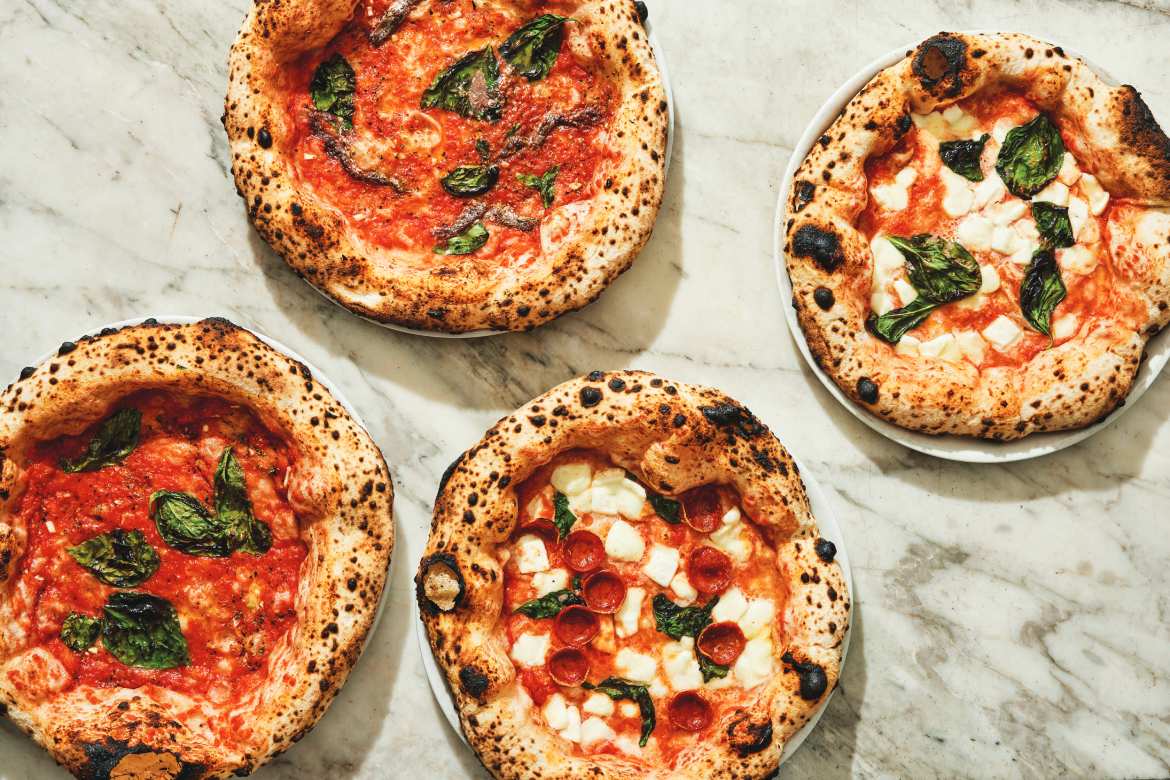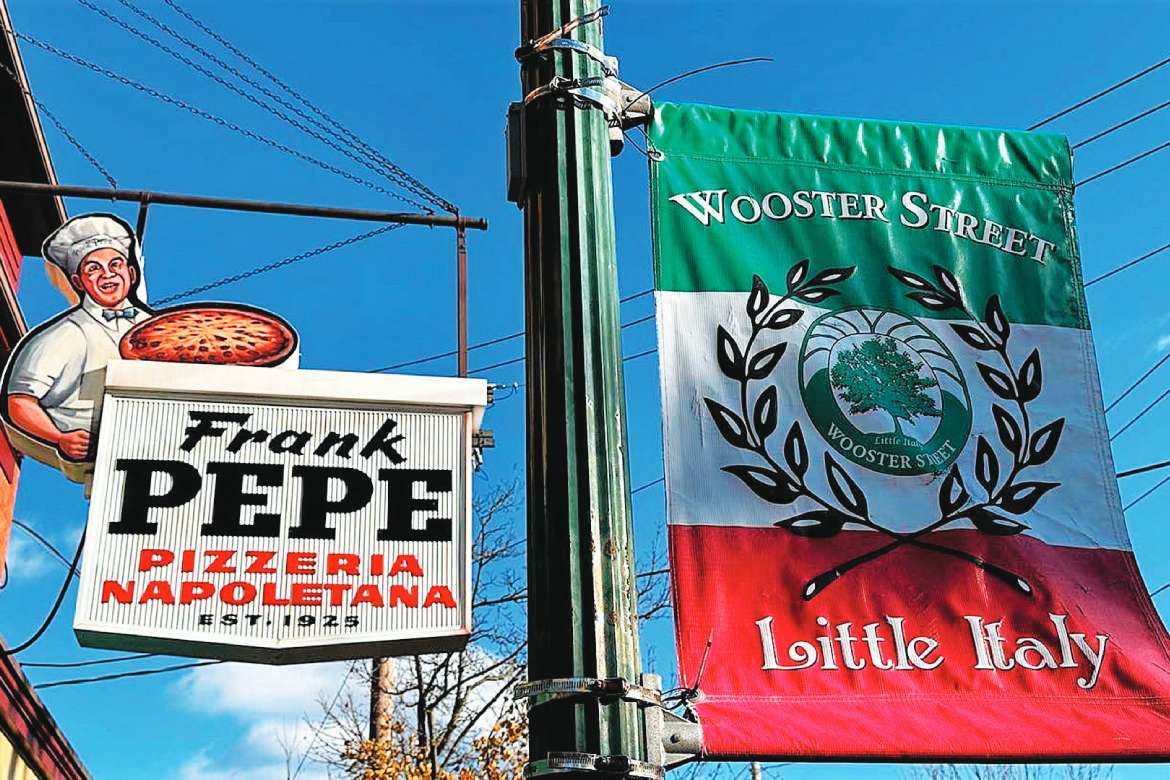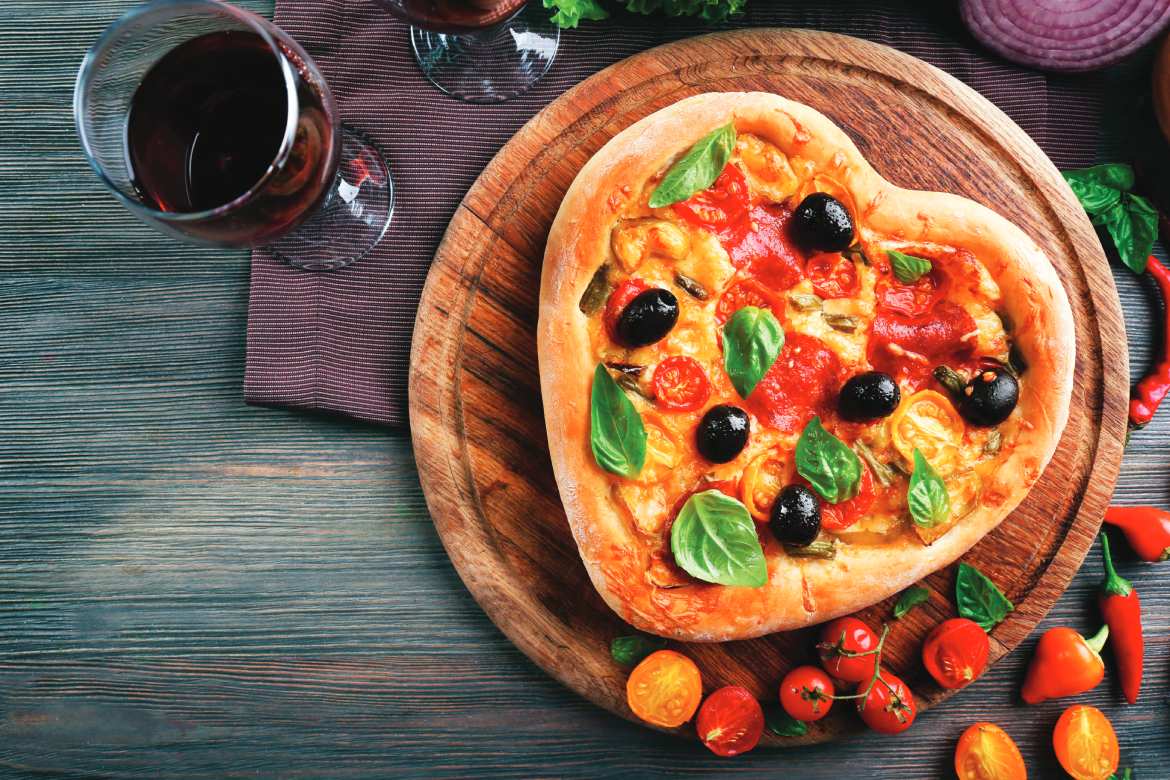My recent five-city pizza tour of the Northeast, the cradle of the immigrant experience for Italians in America along with the Albanians, Lebanese, Greeks and other groups that later joined the pizza party, was an eye-opening journey.
From the 1860’s on, waves of dislocated, impoverished southern Italians embarked on a decades-long diaspora to America and elsewhere. Their 3,000-mile exodus to the U.S. forever transformed our culture, including the introduction of a once-obscure ethnic street food: pizza.
Originated in ancient Greece, likely derived from pita and describing baked flatbreads with various spreads through the centuries, pizza (“pie” or “cake” in Italian) as we know it today emerged in Italy’s Campania region following the arrival of the tomato in the mid-1500’s.
After Spanish conquistadors discovered the indigenous “xitomatl” in the Peruvian Andes, Columbus and other explorers introduced it to Europe. Another account has the Viceroy of Peru gifting tomato seeds to the King of Naples. Either way, the planting of il pomodoro San Marzano, the official tomato of Associazione Verace Pizza Napoletana (AVPN, or True Neapolitan Pizza Association), in the volcanic soil surrounding Mount Vesuvius seeded a culinary revolution.
Tomato and cheese pizza emerged as a Neapolitan street food in the 1700’s, followed by the city’s first pizzerias in the early 1800s. In 1889, according to lore, Naples chef Raffaele Esposito prepared three pies for visiting Queen Margherita of Savoy. At the last moment, his wife Maria reportedly added basil (green) to the tomato (red) and mozzarella (white) pie. Flying the colors of the Italian flag, thus was born Pizza Margherita.
Pizza expert Scott Wiener, founder of NYC-based Scott’s Pizza Tours (scottspizzatours.com), has debunked that account, noting that “there’s plenty of evidence of tomato, mozzarella, and basil coexisting on pizza before 1889.”
Following the initial émigré waves, pizza’s first documented port of call was reportedly Argentina, in 1882, along with Brazil. America’s turn came in 1894, first appearing in a NYC pizzeria. In the resourceful hands of immigrant women, pizza, born of frugality, was originally about survival. Emerging from early bakeries, it then evolved a new identity, principally in NYC, which throughout the first half of the 20th century, popularized and re-exported (“the Pizza Effect”) pizza to Italy and the world.

Una Pizza Napoletana in NYC (Photo by Mark Weinberg)
Pizza is a quest,siren-calling pilgrims to new destinations and offbeat neighborhoods. For the people behind the pies,some keep history alive while others break the rules.
My recent five-city pizza tour of the Northeast, the cradle of the immigrant experience for Italians in America along with the Albanians, Lebanese, Greeks and other groups that later joined the pizza party, was an eye-opening journey. Pizza is personal, inspiring devotion, debate, reverence, and rivalry. Pizza fires up our endogenous opioid system, producing heightened feelings of pleasure. Pizza is a quest, siren-calling pilgrims to new destinations and offbeat neighborhoods. For the people behind the pies, some keep history alive while others break the rules. All will have you saying “Per fortuna che hanno inventato la pizza!” (Luckily they invented pizza!).
IN NEW HAVEN, IT’S CALLED “APIZZA”
“This is how we dough it” proclaimed the front page of the Hartford Courant in February 2023 in honor of National Pizza Day and the Connecticut General Assembly’s ongoing effort to make pizza the state’s official food.
“We call it Apizza, pronounced ‘a-beets,’ from the Campanian dialect,” said local pizza guru Colin Caplan, author of Pizza in New Haven, co-producer of the documentary Pizza: A Love Story, founder of tour company Taste of New Haven (Tel: 888-975-8664. tasteofnewhaven.com) and a major champion for the initiative.
Apizza, a global culinary calling card for the city and state, is seated in multi-generational family connections. Caplan explained how in the 1880’s, local manufacturing powerhouse Sargent & Co. dispatched agents to Campania to recruit factory workers. Housed near the factory in historic Wooster Square, the resulting Italian enclave became the cradle of apizza.

New Haven Frank Pepe Pizzeria Napoletana (Photo by Jeff Heilman)
“Pizza Row” pioneers included Frank Pepe, a 1909 arrival who, after returning to Italy for WW1, came back and opened his own bakery in 1925 with wife Filomena. In 1936, the father of New Haven wood-fired (before the switch to coal in 1960) apizza opened Frank Pepe Pizzeria Napoletana (157 Wooster St. 203-865-5762. pepespizzeria.com) at its present location. Along with the Original Tomato Pie, I loved the White Clam Pizza, originated by Pepe in 1960. His original bakery, next door, is now Frank Pepe’s the Spot (163 Wooster St. 203-865-7602), serving the same menu.
In 1938, Pepe’s sister, also Filomena, purchased a nearby bakery, and with sons Salvatore (Sally) and Tony Consiglio, who worked at Pepe’s, opened Sally’s Apizza (237 Wooster St. 203-624-5271. www.sallysapizza.com). Baked in a shovel-stoked anthracite coal-fired oven, the hand-formed, irregularly shaped apizza, including the Tomato Sauce Pie and Roman-style Potato & Rosemary pie, are also true tastes of history, along with the time-capsule interior. Tony was inner circle with Frank Sinatra, one of the many celebrity fans whose photos decorate the walls.
Opened in 1934 a mile away, Modern Apizza (874 State St. Tel: 203-776-5306. modernapizza.com) completes the “Holy Trinity” of New Haven originals, serving thin-crust favorites such as the ingredient-packed Italian Bomb. Expect lengthy wait times at all three, especially on weekends.
Back on “Pizza Row,” Zeneli Pizzeria & Cucina Napoletana (138 Wooster Street, 203-745-4194. zenelipizzeria.com) is a current-generation hotspot. Born in Albania and raised in Caserta, Italy, brothers Gazmir, Aleko and Jeshar Zeneli got their pizza- and cheese-making chops down in Naples before moving to NYC, where Gazmir spent nine years as head pizza chef at Eataly NYC. Their signature Queen Margherita pie is fit for royalty, along with the gold-plated wood-fired oven.
Other old school anchors include West Haven’s Zuppardi’s Apizza (179 Union Ave. 203-934-1949. zuppardisapizza.com), opened by Amalfian baker Dominic Zuppardi in 1934.
Opened in 1991, energetic nightclub-meets-brewery BAR New Haven (254 Crown St. Tel: 203-495-8924. barnightclub.com) located near New Haven Green and Yale University serves savory pies cooked in a massive brick oven. Gleefully veering from history, specialty white pizzas include the Mashed Potato & Bacon, BBQ Brisket, and Mexican Street Corn.
PROVIDENCE’S PIZZA PREEMINENCE
Rhode Island’s walkable capital city is a superior culinary destination, pizza included. Founded in 1980 by Rhode Island School of Design art students Johanne Killeen and her late husband George Germon, Al Forno (577 South Water St.Tel: 401-273-9760. alforno.com), put Providence on the national culinary map. In 1993, the couple earned James Beard Best Chef of the Northeast honors in part for their invention of the still-masterful charcoal-grilled pizza.
In 2007, after 17 years at Al Forno, Chef Brian Kingsford and partner Jennifer Matta co-founded nearby Bácaro (262 S. Water St. 401-751-3700. bacarorestaurant.net). Combining a Venetian-inspired “bácari” wine bar with salumeria and upscale dining in a historic two-story waterfront building, their superb grilled thin crust pizzas come with mouthwatering toppings like roasted pumpkin with spicy infused olive oil.
Voted “Most Delicious, Creative and Instagrammable” at the inaugural Providence Pizza Week in April 2022, Francesco’s Pizzeria (357 Hope St. Tel: 401-751-0355. francescospvd.com) is a 2021 newcomer near Brown University (limited outdoor seating only) with classic lineage. Founder Frank Schiavone’s great-, great-, great-uncle Francesco brought his pizza recipe from Campania to the Bronx in 1918 before relocating to Providence. Cooked in a 1,000-degree dual coal-fire brick oven, colorful New York-style pizzas include the General Tso’s chicken and the Triple V (Very, Veggie, Vegan).
Pizza Marvin (468 Wickenden St. Tel: 401-262-3336. pizzamarvin.com) is another recent newcomer in Fox Point on Providence’s East Side. Rhode Islander Robert Andreozzi, whose chef resume includes NYC’s Del Posto Ristorante, fashioned an old-school pizza parlor from a former pizzeria and its well-seasoned oven.
Gingham-printed tabletops set the stage for New Haven-inspired pies that earned Andreozzi a Janes Beard nomination for Best Chef: Northeast in 2023. The square with tangy sauce topped with spicy Calabrian oil and pesto was euphoric, along with the cupped, charred hand-cut pepperoni dotting the chard appled cheese pie. Andreozzi’s acclaimed mixologist partner Jesse Hedberg has crafted canned and bottled cocktails such as the Pepperoni Negroni.
Nearly 19 percent of Rhode Islanders claim Italian ancestry, making the Ocean State the most Italian state in the country. Many settled on Federal Hill, the “Heartbeat of Providence” with its La Pigna (Pine Cone) gateway arch, cobblestone piazza, and corridor ofItalian restaurants, bakeries, and otherstores. Main stays include Caserta Pizzeria (121 Spruce Street. Tel: 401-272-3618. casertapizza.com), which dates to 1953 and was acquired in 1981 by Korean War veteran John Campagnone Sr. Today, son John Jr. carries on the tradition at this authentic landmark with signature orders including the spinach-stuffed “Wimpy Skippy” and sweet sausage-filled Pig in a Blanket and Pepper Pig. All the pies are delicious.
Nearby Sicilia’s Pizzeria (181 Atwells Avenue. Tel: 401-273-9222. siciliasonline.com) is the place to enjoy Lebanese owner Mounir Naddaf’s deep dish stuffed pizza, a Chicago-like cake of tangy sauce with onions, peppers, and various proteins, and refreshing cocktails like the gin with lemonade and lavender.
Turning 10 this year, married couple Frankie and Kara Cecchinelli’s downtown wood-fired eatery Figidini (67 Washington St. Tel: 401-808-6886. figidini.com) is world-class. Inspired by his parents’ commercial wood burning oven restaurants in Massachusetts, Frankie has mastered the art of hovering his peel above the Vesuvian ash-forged floor of his 950-degree oven. Made with classic imported Neapolitan 00 flour and San Marzano tomatoes, what emerges is pizza perfection, served uncut and featuring the fluffiest, chewiest cornicione (crust’s edge) and char I’ve ever tasted. The pie topped with a melting ball of burrata, along with the woodfired boneless chicken wings, are two of the absolute best tastes in town.
BOSTON IS FOR PIZZA PILGRIMS
By 1930, some 44,000 Italians teemed in the North End, investing Boston’s oldest neighborhood (1630) with lasting allure as Hub City’s Little Italy. Early bakeries making pizza from leftover dough include A. Parziale and Sons Italian Bakery (80 Prince St. Tel 617-523-6368. parzialebakery.com), which claims to have introduced pizza to New England in 1907. With bakery origins, Regina Pizzeria (11 Thacher St. Tel: 617-227-0765. pizzeriaregina.com), asserts rights as Boston’s original pizzeria from 1926. Line up at America’s fifth oldest pizzeria for original recipe thin-crust pizza flamed in a gas-fired sand-and-brick oven. Loaded with meat, mozzarella, and vegetables, “The Giambotta” exemplifies Regina’s chewy, flavorsome goodness.
Named an “American Classic” by the James Beard Foundation in 2018, Galleria Umberto (289 Hanover St. Tel: 617-227-5709. galleriaumbrertos.com) is for authentic square-cut Sicilian pizza and arancini, or Italian rice balls. First started as a bakery in 1965, Umberto Deuterio and his wife opened the pizzeria in a former sailors’ refuge in 1974. Run today by sons Paul and Ralph, this locals’ favorite is for thick, chewy, affordable pizza. Around 1895, Italian émigrés began settling in East Boston, creating another Little Italy until the 1970s.
Living legacy Santarpio’s Pizza (111 Chelsea St, East Boston. Tel: 617-567-9871. santarpiospizza.com) opened as a bakery in 1903 and has been serving thin-crust pizza since 1933. This neighborhood tavern has been popularized as a go-to for travelers to nearby Logan Airport, and their spicy sausage rocks, along with the open-pit cooked meat skewers.
While Boston pizza mostly borrows from other regional forms, cracker-thin South Shore bar pizza, cooked in steel pans and classically using American cheddar cheese, is a time-honored dive bar original.

Pizza With Pickles (Photo by Troyka)
“The best pans are old, weathered and seasoned to perfection, just like South Shore native Steven Tyler of Aerosmith fame,” wrote sports and beer journalist Kerry Byrne. Located closer to the city inside South Boston’s Castle Island Brewing, Bardo’s Bar Pizza (10 Old Colony Avenue, South Boston. Tel: 781-951-2029. bardospizza.com) serves zesty pickle-topped and other bar pizza. The more you eat, the more you drink.
In suburban Somerville, Posto (187 Elm Street. Tel: 617-625-0600. postoboston.com) is New England’s first AVPN-designated restaurant. The Red and White pizzas come with wood-fired apples, roasted chicken with BBQ sauce and other savory toppings.
THE NEW YORK CITY PIZZA CONNECTION
New York City’s cultural attachment to pizza, explained Scott Weiner, “reaches farther back than any other city besides Naples.” In 2017, UNESCO honored Neapolitan pizza-making with “intangible cultural heritage” status. Pizza and NYC are likewise synonymous. “While New Haven pizzerias have stayed the same to suit the history, NYC operators adapted to suit the ever-evolving transient culture of a global tourist city,” said Wiener. “Today’s NYC-style pizza is far departed from the Naples precursors.”
While Manhattan’s legendary Lombardi’s (32 Spring St. Tel: 212-941-7994. firstpizza.com) claims rights as America’s first pizzeria from 1905, another pizza sage, Peter Regas, documented a directory listing from 1894 for Giovanni Albano’s Pizzeria at nearby 59 1/2 Mulberry Street. Changing how America and the world thought about pizza, NYC, my home since 1987, is chapter and verse for seekers of truth in pizza. Choosing a short list of favorites is next to impossible, but here we go.
Legendary lineage on Italian-American stronghold Staten Island includes Denino’s Pizzeria & Tavern (524 Port Richmond Ave. Tel: 718-442-9401. deninossi.com). Sicilian émigré Giovanni Denino started with a candy store (1923) and pool hall (1925) before opening the present tavern-style restaurant in 1937. In 1951, son Carlo added pizza to the menu, with thin crust pies like the “M.O.R.” (Meatball, Onion, Ricotta) providing a taste of history to this day. Founded in 1960 by the Pappalardo brothers, Joe & Pat’s (1758 Victory Blvd. Tel: 718-981-0887) is another family affair, along with circa-1975 Brother’s Pizzeria (750 Port Richmond Ave. Tel: 718-442-2332) from serial pizza champion Giorgio “The Pizza King” Giove.
Quests in Queens include Dani’s House of Pizza (81-28 Lefferts Blvd. Tel: 718-846-2849. danishouseofpizza.com). Founded in 1959 by Albanian émigré Ramiz Dani, who later helped fellow Albanians establish pizza shops across Queens and Brooklyn, this Kew Gardens landmark, run by Dani’s son Sabri, is renowned for sweetly sauced pies. RSVP in advance for the dine-in only Fresh Shucked Clam Pie at Andrew Belluci’s Pizzeria (37-08 30th Avenue. Tel: 718-407-2497. andrewbelluccispizzeria.com) in Astoria.
Bronx beacons include Sicilian saxophonist Salvatore Natale’s Pugsley Pizza (590 East 191st Street. Tel: 718-365-0327). Emigrating to the U.S. in 1967, Natale played venues across the country. In 1985, he transformed a junk yard across from Fordham University into his artful, eclectic place of positive vibes, where in Sal’s good words, “anyone can make pizza, but not everyone can make pizza with love”.
Stars of Brooklyn’s pizza constellation include Luigi’s Pizza (686 5th Avenue. Tel: 718-499-3857. luigispizzabrooklyn.com). Arriving in 1961 from Calabria, Luigi Lanzo worked at Brooklyn’s Green-Wood Cemetery during the day and made pizza at night. In 1973, he opened his beloved namesake pizzeria. Laid to rest at nearby Green-Wood in 2021, Lanzo investment is now in son Giovanni’s hands. Following mother Teodora’s recipe, the subtly sweet sauce, fresh mozzarella and other ingredients reign supreme. The authentic retro façade with its flashing bulb sign is pizza cinema.
Gentrification aside, Carroll Gardens near Downtown Brooklyn remains an influential Italian-American center. Slice shops abound, along with no-reservation, BYOB Lucali (575 Henry St. 718-858-4086. lucali.com). Purists frown on calling pizzamakers “pizzaiolos” outside of Naples, but owner Mark Iacono, born and raised in the neighborhood, is a bona fide master of the art.
Massimo Laveglia, from Pistoia near Florence, Italy, set the pizza world on fire in 2017 with L’Industrie Pizzeria (254 S 2nd St. Tel: 718-599-0002. lindustriebk.com) in another diversified historic Italian neighborhood, Williamsburg. Creations like the Fig Jam white pie with mozzarella, fig jam, bacon, and ricotta set this shop apart.
In the 1940’s, young Patsy Grimaldi trained with his uncle, former Lombardi’s pizzaiolo Pasquale “Patsy” Lancieri, at legendary Patsy’s (1931) in East Harlem (see below). In 1990, Grimaldi opened his namesake pizzeria under the
Brooklyn Bridge in Brooklyn’s DUMBO neighborhood. According to Wiener, Grimaldi’s return to the original coal-fired, brick oven method “kicked off a pizza renaissance, if not revolution, in NYC and really, America.”
In 2012, Grimaldi revived his original space in 2012 as Juliana’s Pizza (19 Old Fulton St. Tel: 718-596-6700. julianaspizza.com). Named after his mother, it’s revolutionary all over again. Using the same 800-degree coal-fired oven, the mix of sweet-sauced classic and specialty pies such as prosciutto and fennel sausage have put the legacy back on the map.
Once frequented by Frank Sinatra, Dean Martin and Tony Bennett, the time capsule dining room at the original Patsy’s (2287 1st Ave. Tel: 212-534-9783) inspired Francis Ford Coppola’s scene-setting in The Godfather. Make the pilgrimage to 117th Street for faithful Naples-style soft crusted, charred pies with red sauce and fresh mozzarella circles. Arturo’s (106 W. Houston St. Tel: 212-677-3820) is a West Village winner that has stayed true since 1957 with superb coal-fired pies accompanied by nightly live jazz.

Anthony Mangieri, Una Pizza Napoletana in NYC (Photo by NYC Una Pizza Napoletana, Anthony Mangieri)
Practice has made perfect for Anthony Mangieri, the pioneering pizza obsessive behind Una Pizza Napoletana (175 Orchard St. Tel: 646-476-4457. unapizza.com). Originally a baker, the New Jersey native began crafting his naturally-leavened, wood-fired Neapolitan pizza in Point Pleasant Beach, N.J. in 1996. After four relocations, including twice in lower Manhattan, San Francisco and New Jersey’s Atlantic Highlands, he opened his current Lower East Side location in March 2022. Last summer, Italy based pizza ranking site 50 Top Pizza named Una Pizza Napoletana number one in America and the world’s best in a tie with Masanielli di Francesco Martucci, north of Naples.
PHILADELPHIA IS PIZZA PROUD
Second behind NYC in Italian-American ancestry, Philadelphia’s culinary heart beats red, white, and green. The first arrivals, in Colonial times, came from more prosperous northern Italy. It was the later emigres, from southern Italy, who indelibly stamped the food scene not with pizza, but with sandwiches. The cheesesteak, roast pork Italian, stromboli, tomato pie (an enduring original of leftover dough with tomato sauce), and the “Hog Island” or hoagie, Philly’s official sandwich, all offer a true taste of place.
Not to be overshadowed, pizza also places in the tradition with a mix of vintage and modern shops. Settled by Italian immigrants in 1798, South Philadelphia’s Bella Vista (beautiful sight) neighborhood is for (cash- and take out only) Angelo’s Pizzeria South Philadelphia (736 S. 9th St. Tel: 215-922-0000. angelospizzeriasouthphiladelphia.com) and perky pies like the Diavlo with hot sausage and Italian long hot peppers.


